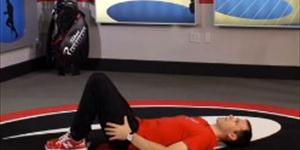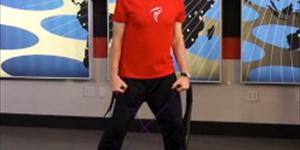IMPROVE MY GAME
Articles
The King
The King
In the golf swing there may be no more important multi-function muscle than the Gluts. This entire muscle group is vital in helping the golfer to maintain lower body stability throughout the swing. It is also vital in helping to maintain core stability throughout the swing. It is this one muscle group that helps to blend the lower body movement into the upper body movements, via the central portion of the body (the Core). Therefore it is of utmost importance to have this muscle group functioning at its optimal levels in order to attain a repeatable and consistent swing. For this reason, we have termed the gluts as the “King of the Golf Swing”.
In this workout we are going to tackle two main components of the gluts;
• Gluteus Maximus
• Gluteus Medius
Both of these muscle groups play a very important role at both developing power and consistency in the golf swing. Without both of these groups working together in harmony, one or both of the aforementioned characteristics will suffer.
The following exercise routine has been developed at TPI to create a firm foundation in both the lower body and the core for golfers of all ages, handicaps and walks of life. This program should be included as part of your entire routine, as each golfer will possess individual nuances that will separate him or her from the others.
To establish Gluteus Maximus strength, we typically recommend the following three drills. These drills are foundational and will help the brain and the muscle starting communicating with one another. This is can present as a major roadblock for the golfing population. In essence we will be learning “muscle memory”. We will teach the muscles how to fire and then remember so that we can call on them again and again for the same purpose. This in turn will help to limit both our misses on the golf course and prevent uneeded injuries and trauma.
• Deer in the Headlights – This drill is used to train the mind and the glutei muscle to work in unison. Typically we see a co-contraction of the glut along with the hamstring and/or lower back. It is the intent of the brain to fire the gluts, but for many reasons the hamstrings and/or lower back tends to either take over or help out too much! By establishing a direct pathway between the brain and the “correct” muscle you will be breaking a negative cycle that tends to lead to both injuries and poor play. This drill does not typically come with a standard number of sets and reps; rather it is something that can be practiced for a few seconds here and there during your entire day. The more you practice this drill in different settings (supine, seated, standing, golf posture, prone etc…) the more your gluts will become familiar with activating properly.
• Bridging Two Legs – 2 sets of 10 reps each. Hold each repetition for 10 seconds. This will give you approximately 200 seconds of gluteus contraction. During a normal round of golf the gluts become active for roughly 2 seconds per golf swing. Multiply this number by an average of 50 strokes per round, and 100 practice swings, and you get roughly 300 seconds of glut activation (based of an average score of 85, with 35 putts).
• Bridging One Leg – 2 sets of 3-5 reps each. Hold each repetition for approximately 3-5 seconds. This time period will increase as your glut strength increases. If you feel a cramp coming on in the hamstring or lower back region, discontinue the exercise immediately. This is a sign that the glut muscle is being shut off and the hamstring/lower back is taking over. It is our goal to work through this issue by reprogramming the mind’s control over specific muscle groups (gluts).
To establish the Gluteus Medius muscle group we are going to focus on two important drills. ATTENTION- these two drills will induce some muscle burn when performed correctly. Nobody ever got to be the KING without a little burn! The Gluteus Medius really helps to prevent excessive lateral movement during the golf swing. This can help maximize rotary movement, which can help to increase your golf swing’s power.
• Duck Walks – 2-3 sets in each direction, until you reach point of burn! Make sure to get into proper golf posture (5-iron setup will suffice). With correct posture established, you will make sure your upper body remains very quiet and your lower body is driving the exercise. Try to locate the burn into the sides of the butt (gluteus medius), rather than down the outside of the legs (TFL). Set up with more of your weight towards the heels rather than towards the toes. During the drill, make sure you mentally focus on which portion of the body should be feeling the burn/activation (side of the butt!!!).
• Side Leg Lifts – 2-3 sets in each direction, until you reach point of burn. In a side-lying position, with hips directly on top of one another, make sure to bend lower knee to a 90 degree angle. With top hand, isolate the top of the pelvis and secure its position (this bone shall not move!!!). During the leg raise, keep foot positioned at a 90 degree angle and only raise leg straight towards the ceiling. Never allow the foot to pop forward, while the hip shoots backwards. This drill should be felt into the side of the butt and no place else. It is imperative to lock the Iliac Crest (top portion of pelvis that hand is grasping) in place and allow the leg to rise from the actual “hip” joint.
Try these five drills in hopes of establishing your royal family of Gluts! It is sure to create a more stable lower platform as well as improve the function of the core. Be sure to check out “The Queen”, as the two programs seem to work very well in conjunction with one another.


